SAP S/4HANA Finance: Overview, Benefits, and Issues
VerifiedAdded on 2023/04/21
|20
|4513
|221
AI Summary
This essay provides an overview of SAP S/4HANA Finance and its importance in financial management. It discusses the difference between SAP ERP FICO and SAP S/4HANA Finance, the benefits of SAP S/4HANA Finance for businesses, and the issues faced during migration. The essay also includes a case study on Cathay Pacific Airways' migration to SAP S/4HANA Finance.
Contribute Materials
Your contribution can guide someone’s learning journey. Share your
documents today.
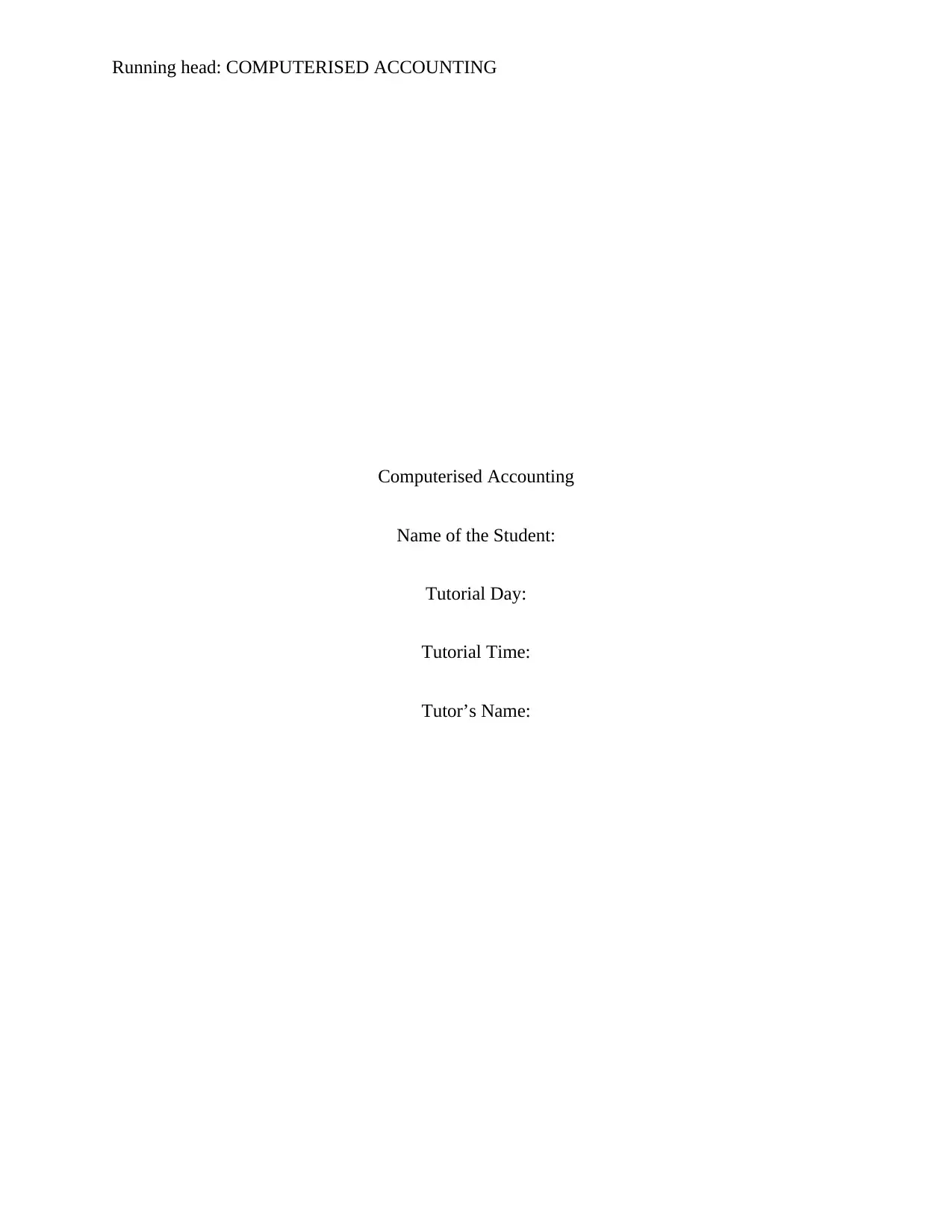
Running head: COMPUTERISED ACCOUNTING
Computerised Accounting
Name of the Student:
Tutorial Day:
Tutorial Time:
Tutor’s Name:
Computerised Accounting
Name of the Student:
Tutorial Day:
Tutorial Time:
Tutor’s Name:
Secure Best Marks with AI Grader
Need help grading? Try our AI Grader for instant feedback on your assignments.

COMPUTERISED ACCOUNTING
Introduction:
Enterprise Resource Planning (ERP) is utilised for accounting, inventory control and
human resource of an organisation. This is used to improve the business of an organisation by
sharing information, business planning and decision-making (Bahssas, AlBar & Hoque 2015).
This essay would provide a brief overview of SAP S/4HANA Finance and its importance in
financial management. The section part would elaborate the difference between SAP S/4HANA
Finance and current SAP ERP FICO. The next section would emphasise on the benefits of SAP
S/4HANA Finance for business organisations. Finally, the essay would shed light on the issues
encountered by the real life organisations at the time of shifting to SAP S/4 HANA Finance.
Historical overview of SAP S/4HANA Finance:
SAP S/4HANA Finance could be defined as a financial application in the SAP S/4HANA
ERP platform. It comprises of a group of interrelated functions of financial management
providing real-time data from the ERP applications. SAP S/4HANA Finance is a portion of
S/4HANA and it is developed on the SAP HANA in-memory database platform (Bressler 2014).
S/4HANA is involved in integrating cross-organisational functions into a system, which
combines transactional analytics and processes for real-time applications. In case of the front
end, SAP S/4HANA Finance utilises SAP Fiori for personalised and consumer-like experience.
SAP first launched SAP HANA in 2011 in the form of next generation in-memory
platform developed as the great simplifier for the customers for inventing and reinventing
business through real-time insight. SAP Business Suite has been introduced in January 2013 so
that the organisations could drive real-time business along with simplifying the running
Name:
Student ID:
1 | P a g e
Introduction:
Enterprise Resource Planning (ERP) is utilised for accounting, inventory control and
human resource of an organisation. This is used to improve the business of an organisation by
sharing information, business planning and decision-making (Bahssas, AlBar & Hoque 2015).
This essay would provide a brief overview of SAP S/4HANA Finance and its importance in
financial management. The section part would elaborate the difference between SAP S/4HANA
Finance and current SAP ERP FICO. The next section would emphasise on the benefits of SAP
S/4HANA Finance for business organisations. Finally, the essay would shed light on the issues
encountered by the real life organisations at the time of shifting to SAP S/4 HANA Finance.
Historical overview of SAP S/4HANA Finance:
SAP S/4HANA Finance could be defined as a financial application in the SAP S/4HANA
ERP platform. It comprises of a group of interrelated functions of financial management
providing real-time data from the ERP applications. SAP S/4HANA Finance is a portion of
S/4HANA and it is developed on the SAP HANA in-memory database platform (Bressler 2014).
S/4HANA is involved in integrating cross-organisational functions into a system, which
combines transactional analytics and processes for real-time applications. In case of the front
end, SAP S/4HANA Finance utilises SAP Fiori for personalised and consumer-like experience.
SAP first launched SAP HANA in 2011 in the form of next generation in-memory
platform developed as the great simplifier for the customers for inventing and reinventing
business through real-time insight. SAP Business Suite has been introduced in January 2013 so
that the organisations could drive real-time business along with simplifying the running
Name:
Student ID:
1 | P a g e
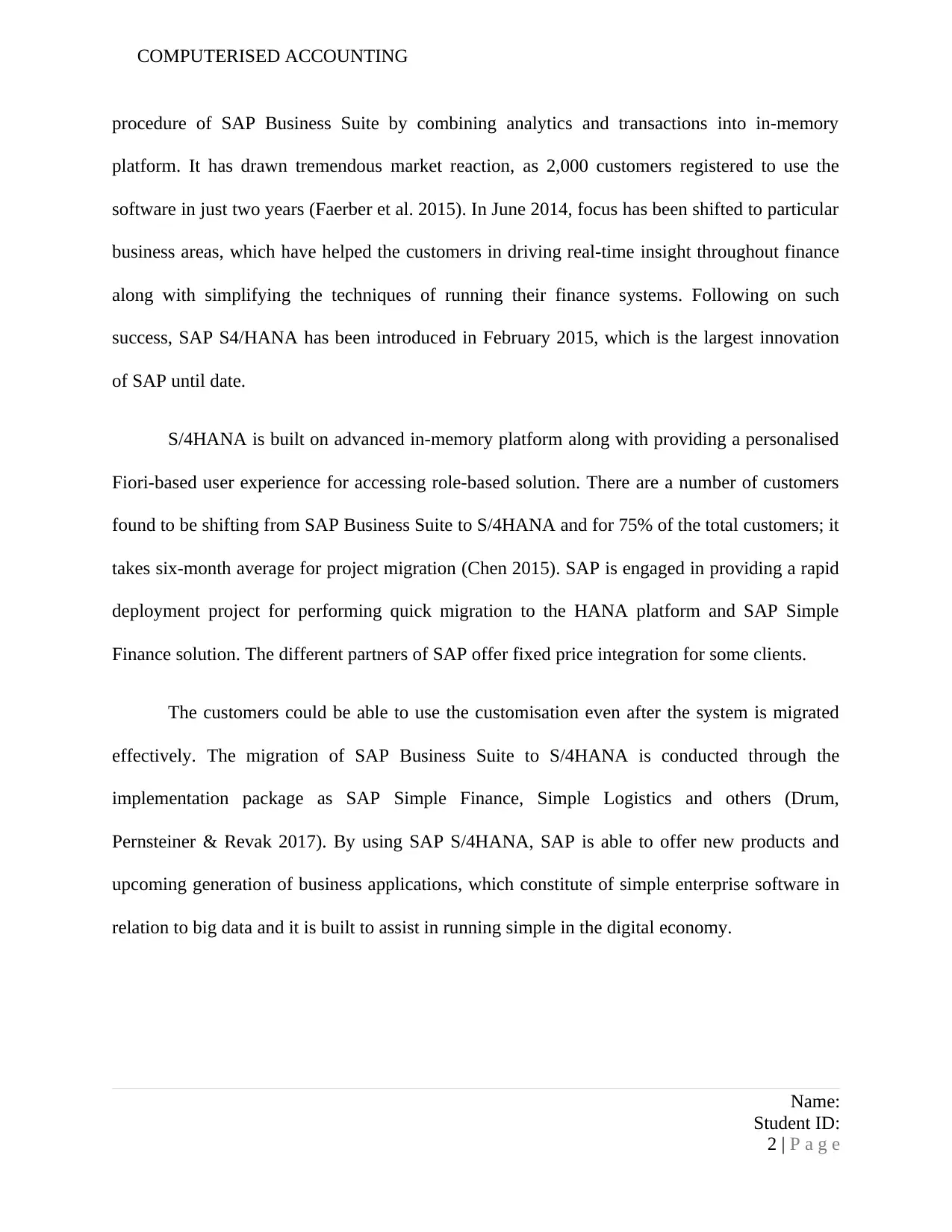
COMPUTERISED ACCOUNTING
procedure of SAP Business Suite by combining analytics and transactions into in-memory
platform. It has drawn tremendous market reaction, as 2,000 customers registered to use the
software in just two years (Faerber et al. 2015). In June 2014, focus has been shifted to particular
business areas, which have helped the customers in driving real-time insight throughout finance
along with simplifying the techniques of running their finance systems. Following on such
success, SAP S4/HANA has been introduced in February 2015, which is the largest innovation
of SAP until date.
S/4HANA is built on advanced in-memory platform along with providing a personalised
Fiori-based user experience for accessing role-based solution. There are a number of customers
found to be shifting from SAP Business Suite to S/4HANA and for 75% of the total customers; it
takes six-month average for project migration (Chen 2015). SAP is engaged in providing a rapid
deployment project for performing quick migration to the HANA platform and SAP Simple
Finance solution. The different partners of SAP offer fixed price integration for some clients.
The customers could be able to use the customisation even after the system is migrated
effectively. The migration of SAP Business Suite to S/4HANA is conducted through the
implementation package as SAP Simple Finance, Simple Logistics and others (Drum,
Pernsteiner & Revak 2017). By using SAP S/4HANA, SAP is able to offer new products and
upcoming generation of business applications, which constitute of simple enterprise software in
relation to big data and it is built to assist in running simple in the digital economy.
Name:
Student ID:
2 | P a g e
procedure of SAP Business Suite by combining analytics and transactions into in-memory
platform. It has drawn tremendous market reaction, as 2,000 customers registered to use the
software in just two years (Faerber et al. 2015). In June 2014, focus has been shifted to particular
business areas, which have helped the customers in driving real-time insight throughout finance
along with simplifying the techniques of running their finance systems. Following on such
success, SAP S4/HANA has been introduced in February 2015, which is the largest innovation
of SAP until date.
S/4HANA is built on advanced in-memory platform along with providing a personalised
Fiori-based user experience for accessing role-based solution. There are a number of customers
found to be shifting from SAP Business Suite to S/4HANA and for 75% of the total customers; it
takes six-month average for project migration (Chen 2015). SAP is engaged in providing a rapid
deployment project for performing quick migration to the HANA platform and SAP Simple
Finance solution. The different partners of SAP offer fixed price integration for some clients.
The customers could be able to use the customisation even after the system is migrated
effectively. The migration of SAP Business Suite to S/4HANA is conducted through the
implementation package as SAP Simple Finance, Simple Logistics and others (Drum,
Pernsteiner & Revak 2017). By using SAP S/4HANA, SAP is able to offer new products and
upcoming generation of business applications, which constitute of simple enterprise software in
relation to big data and it is built to assist in running simple in the digital economy.
Name:
Student ID:
2 | P a g e
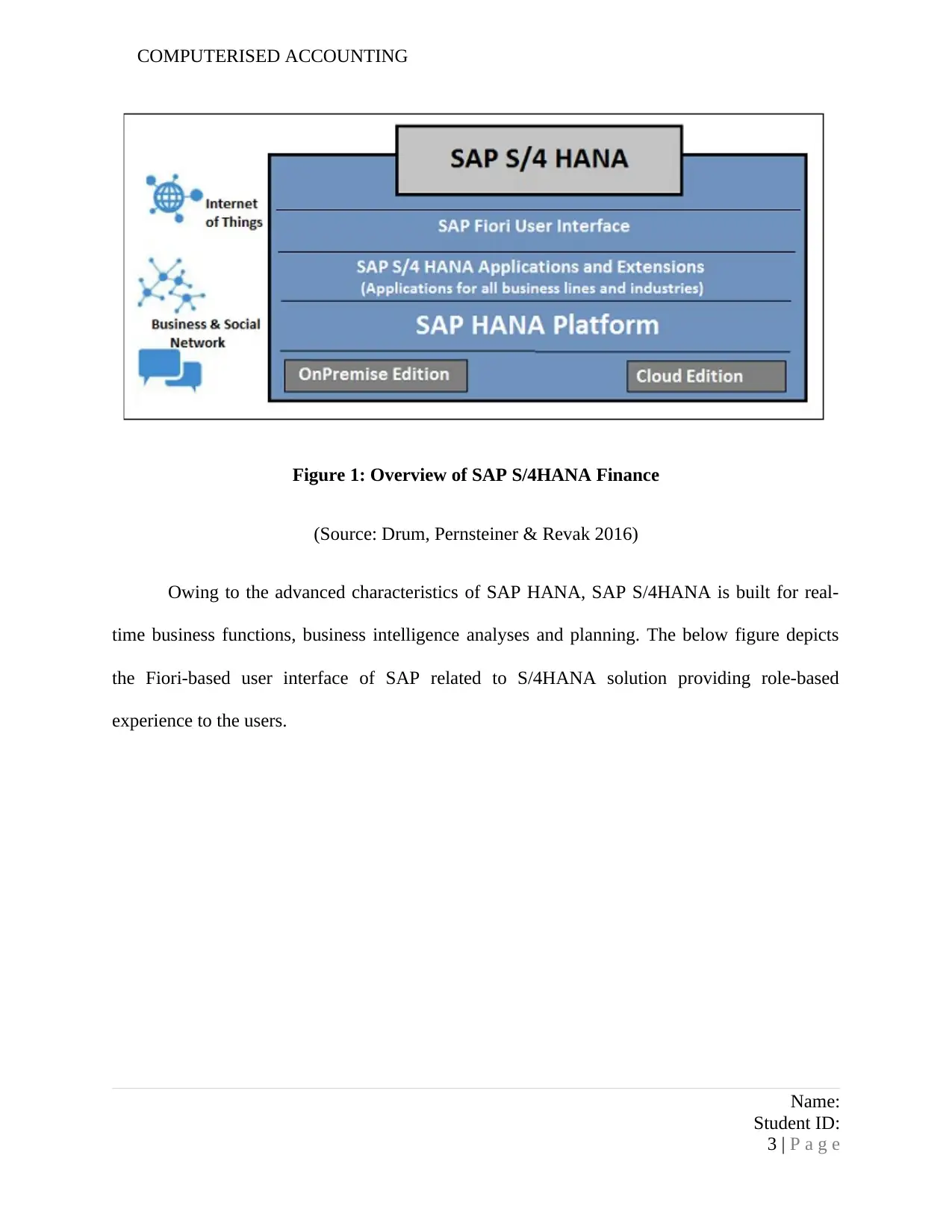
COMPUTERISED ACCOUNTING
Figure 1: Overview of SAP S/4HANA Finance
(Source: Drum, Pernsteiner & Revak 2016)
Owing to the advanced characteristics of SAP HANA, SAP S/4HANA is built for real-
time business functions, business intelligence analyses and planning. The below figure depicts
the Fiori-based user interface of SAP related to S/4HANA solution providing role-based
experience to the users.
Name:
Student ID:
3 | P a g e
Figure 1: Overview of SAP S/4HANA Finance
(Source: Drum, Pernsteiner & Revak 2016)
Owing to the advanced characteristics of SAP HANA, SAP S/4HANA is built for real-
time business functions, business intelligence analyses and planning. The below figure depicts
the Fiori-based user interface of SAP related to S/4HANA solution providing role-based
experience to the users.
Name:
Student ID:
3 | P a g e
Secure Best Marks with AI Grader
Need help grading? Try our AI Grader for instant feedback on your assignments.
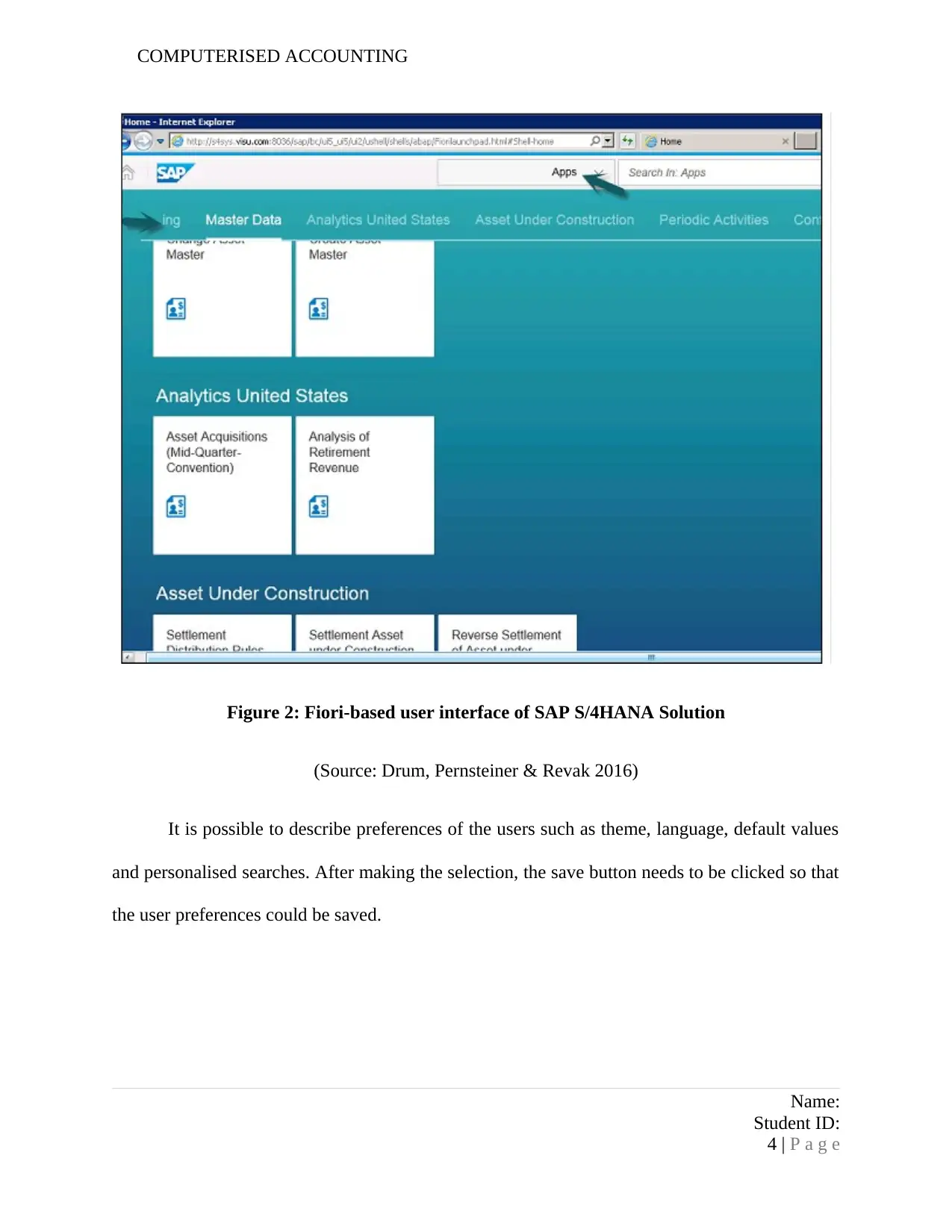
COMPUTERISED ACCOUNTING
Figure 2: Fiori-based user interface of SAP S/4HANA Solution
(Source: Drum, Pernsteiner & Revak 2016)
It is possible to describe preferences of the users such as theme, language, default values
and personalised searches. After making the selection, the save button needs to be clicked so that
the user preferences could be saved.
Name:
Student ID:
4 | P a g e
Figure 2: Fiori-based user interface of SAP S/4HANA Solution
(Source: Drum, Pernsteiner & Revak 2016)
It is possible to describe preferences of the users such as theme, language, default values
and personalised searches. After making the selection, the save button needs to be clicked so that
the user preferences could be saved.
Name:
Student ID:
4 | P a g e
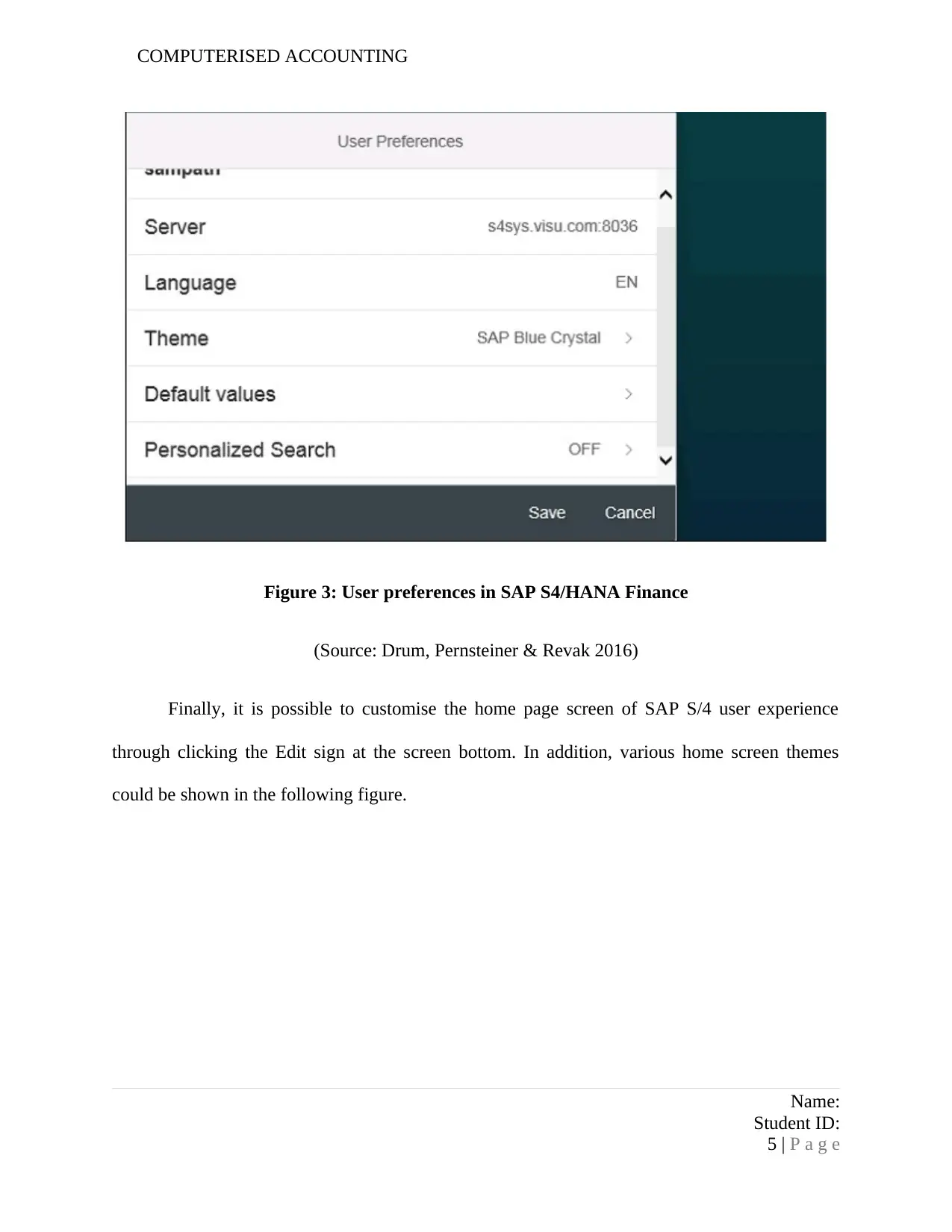
COMPUTERISED ACCOUNTING
Figure 3: User preferences in SAP S4/HANA Finance
(Source: Drum, Pernsteiner & Revak 2016)
Finally, it is possible to customise the home page screen of SAP S/4 user experience
through clicking the Edit sign at the screen bottom. In addition, various home screen themes
could be shown in the following figure.
Name:
Student ID:
5 | P a g e
Figure 3: User preferences in SAP S4/HANA Finance
(Source: Drum, Pernsteiner & Revak 2016)
Finally, it is possible to customise the home page screen of SAP S/4 user experience
through clicking the Edit sign at the screen bottom. In addition, various home screen themes
could be shown in the following figure.
Name:
Student ID:
5 | P a g e
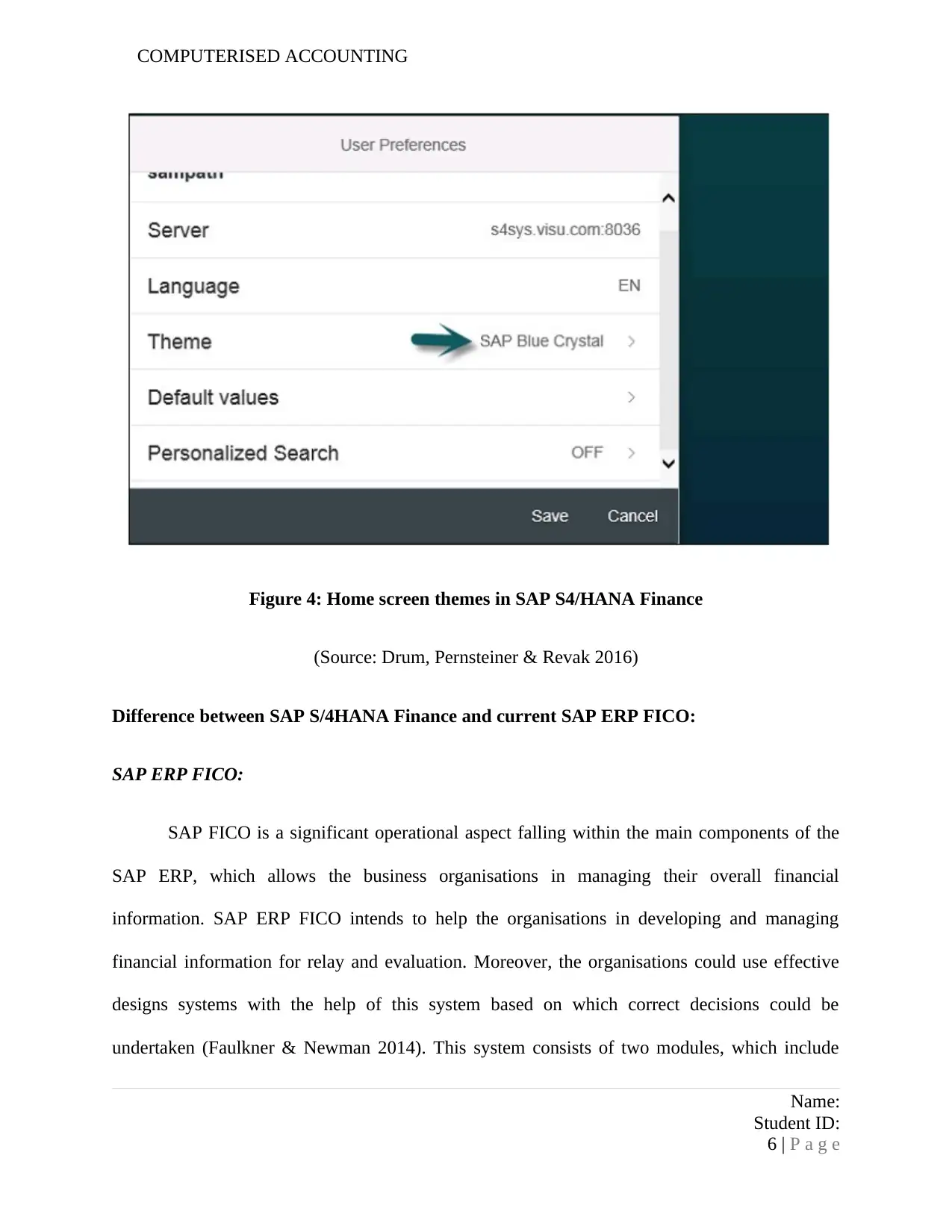
COMPUTERISED ACCOUNTING
Figure 4: Home screen themes in SAP S4/HANA Finance
(Source: Drum, Pernsteiner & Revak 2016)
Difference between SAP S/4HANA Finance and current SAP ERP FICO:
SAP ERP FICO:
SAP FICO is a significant operational aspect falling within the main components of the
SAP ERP, which allows the business organisations in managing their overall financial
information. SAP ERP FICO intends to help the organisations in developing and managing
financial information for relay and evaluation. Moreover, the organisations could use effective
designs systems with the help of this system based on which correct decisions could be
undertaken (Faulkner & Newman 2014). This system consists of two modules, which include
Name:
Student ID:
6 | P a g e
Figure 4: Home screen themes in SAP S4/HANA Finance
(Source: Drum, Pernsteiner & Revak 2016)
Difference between SAP S/4HANA Finance and current SAP ERP FICO:
SAP ERP FICO:
SAP FICO is a significant operational aspect falling within the main components of the
SAP ERP, which allows the business organisations in managing their overall financial
information. SAP ERP FICO intends to help the organisations in developing and managing
financial information for relay and evaluation. Moreover, the organisations could use effective
designs systems with the help of this system based on which correct decisions could be
undertaken (Faulkner & Newman 2014). This system consists of two modules, which include
Name:
Student ID:
6 | P a g e
Paraphrase This Document
Need a fresh take? Get an instant paraphrase of this document with our AI Paraphraser
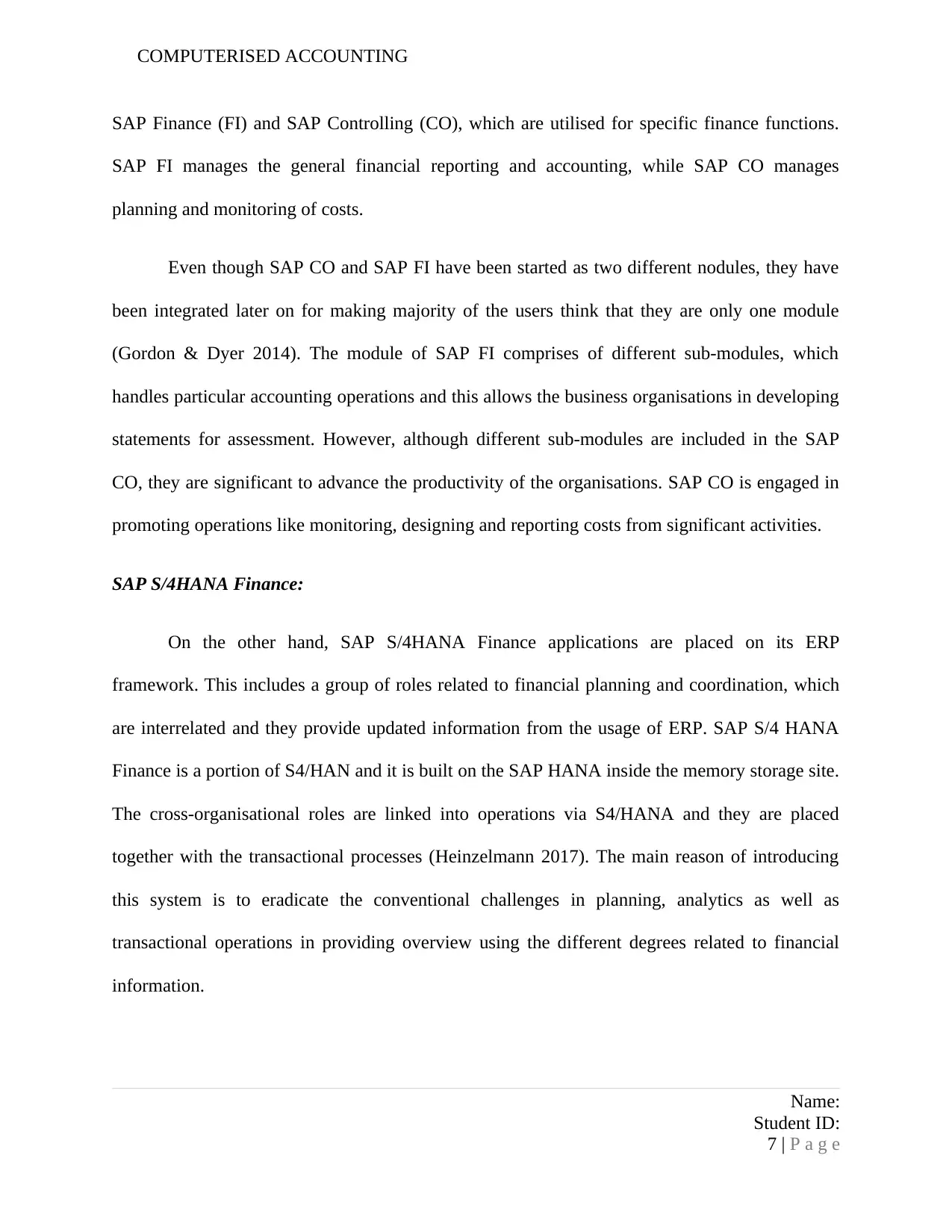
COMPUTERISED ACCOUNTING
SAP Finance (FI) and SAP Controlling (CO), which are utilised for specific finance functions.
SAP FI manages the general financial reporting and accounting, while SAP CO manages
planning and monitoring of costs.
Even though SAP CO and SAP FI have been started as two different nodules, they have
been integrated later on for making majority of the users think that they are only one module
(Gordon & Dyer 2014). The module of SAP FI comprises of different sub-modules, which
handles particular accounting operations and this allows the business organisations in developing
statements for assessment. However, although different sub-modules are included in the SAP
CO, they are significant to advance the productivity of the organisations. SAP CO is engaged in
promoting operations like monitoring, designing and reporting costs from significant activities.
SAP S/4HANA Finance:
On the other hand, SAP S/4HANA Finance applications are placed on its ERP
framework. This includes a group of roles related to financial planning and coordination, which
are interrelated and they provide updated information from the usage of ERP. SAP S/4 HANA
Finance is a portion of S4/HAN and it is built on the SAP HANA inside the memory storage site.
The cross-organisational roles are linked into operations via S4/HANA and they are placed
together with the transactional processes (Heinzelmann 2017). The main reason of introducing
this system is to eradicate the conventional challenges in planning, analytics as well as
transactional operations in providing overview using the different degrees related to financial
information.
Name:
Student ID:
7 | P a g e
SAP Finance (FI) and SAP Controlling (CO), which are utilised for specific finance functions.
SAP FI manages the general financial reporting and accounting, while SAP CO manages
planning and monitoring of costs.
Even though SAP CO and SAP FI have been started as two different nodules, they have
been integrated later on for making majority of the users think that they are only one module
(Gordon & Dyer 2014). The module of SAP FI comprises of different sub-modules, which
handles particular accounting operations and this allows the business organisations in developing
statements for assessment. However, although different sub-modules are included in the SAP
CO, they are significant to advance the productivity of the organisations. SAP CO is engaged in
promoting operations like monitoring, designing and reporting costs from significant activities.
SAP S/4HANA Finance:
On the other hand, SAP S/4HANA Finance applications are placed on its ERP
framework. This includes a group of roles related to financial planning and coordination, which
are interrelated and they provide updated information from the usage of ERP. SAP S/4 HANA
Finance is a portion of S4/HAN and it is built on the SAP HANA inside the memory storage site.
The cross-organisational roles are linked into operations via S4/HANA and they are placed
together with the transactional processes (Heinzelmann 2017). The main reason of introducing
this system is to eradicate the conventional challenges in planning, analytics as well as
transactional operations in providing overview using the different degrees related to financial
information.
Name:
Student ID:
7 | P a g e

COMPUTERISED ACCOUNTING
The financial professionals and experts working in different industries apply SAP
S/4HANA Finance. In addition, this system is possible to be adopted in the cloud or even on-
premise. As a result, it helps in providing a number of alternatives for the system users
(Kalaimani 2016). Besides, the usability of SAP S/4HANA Finance could be adopted in the form
of a self-contained product or integrated depending on the tendency of the customers or the
needs of the organisations.
Benefits of SAP S/4HANA Finance for businesses:
SAP S/4HANA Finance has a number of benefits, which are associated with its use
within a business organisation. It has been observed that there are a number of organisations
adopting this system, which has helped them in undertaking accurate decisions (Kale 2014). The
primary benefit of this system is that it assists a firm in migrating from the last lengthy batch-
dependent operations to real-time operations. Hence, it allows the organisations in running their
financial systems effectively and timely. This minimises the time spent by the organisations at
the time of undertaking decision, as there is availability of data and the managers need to apply it
in undertaking significant decisions within their organisations. Along with this, there has been
global recognition of SAP S/4HANA Finance in order to coordinate financial operations, which
represents that the financial applications have retrieved identical information that would be
updated in the long-run (Keuper & Lueg 2015). This would allow all the individuals within the
organisations to access the necessary information that would aid in easy monitoring of finances.
Moreover, this system aids in eradication of data lay-offs and this reduces the chance of
replication of information. As a result, the management finds it easy in terms of identification
and follow-up with the movements of cash from the contributors; thereby, providing better
Name:
Student ID:
8 | P a g e
The financial professionals and experts working in different industries apply SAP
S/4HANA Finance. In addition, this system is possible to be adopted in the cloud or even on-
premise. As a result, it helps in providing a number of alternatives for the system users
(Kalaimani 2016). Besides, the usability of SAP S/4HANA Finance could be adopted in the form
of a self-contained product or integrated depending on the tendency of the customers or the
needs of the organisations.
Benefits of SAP S/4HANA Finance for businesses:
SAP S/4HANA Finance has a number of benefits, which are associated with its use
within a business organisation. It has been observed that there are a number of organisations
adopting this system, which has helped them in undertaking accurate decisions (Kale 2014). The
primary benefit of this system is that it assists a firm in migrating from the last lengthy batch-
dependent operations to real-time operations. Hence, it allows the organisations in running their
financial systems effectively and timely. This minimises the time spent by the organisations at
the time of undertaking decision, as there is availability of data and the managers need to apply it
in undertaking significant decisions within their organisations. Along with this, there has been
global recognition of SAP S/4HANA Finance in order to coordinate financial operations, which
represents that the financial applications have retrieved identical information that would be
updated in the long-run (Keuper & Lueg 2015). This would allow all the individuals within the
organisations to access the necessary information that would aid in easy monitoring of finances.
Moreover, this system aids in eradication of data lay-offs and this reduces the chance of
replication of information. As a result, the management finds it easy in terms of identification
and follow-up with the movements of cash from the contributors; thereby, providing better
Name:
Student ID:
8 | P a g e
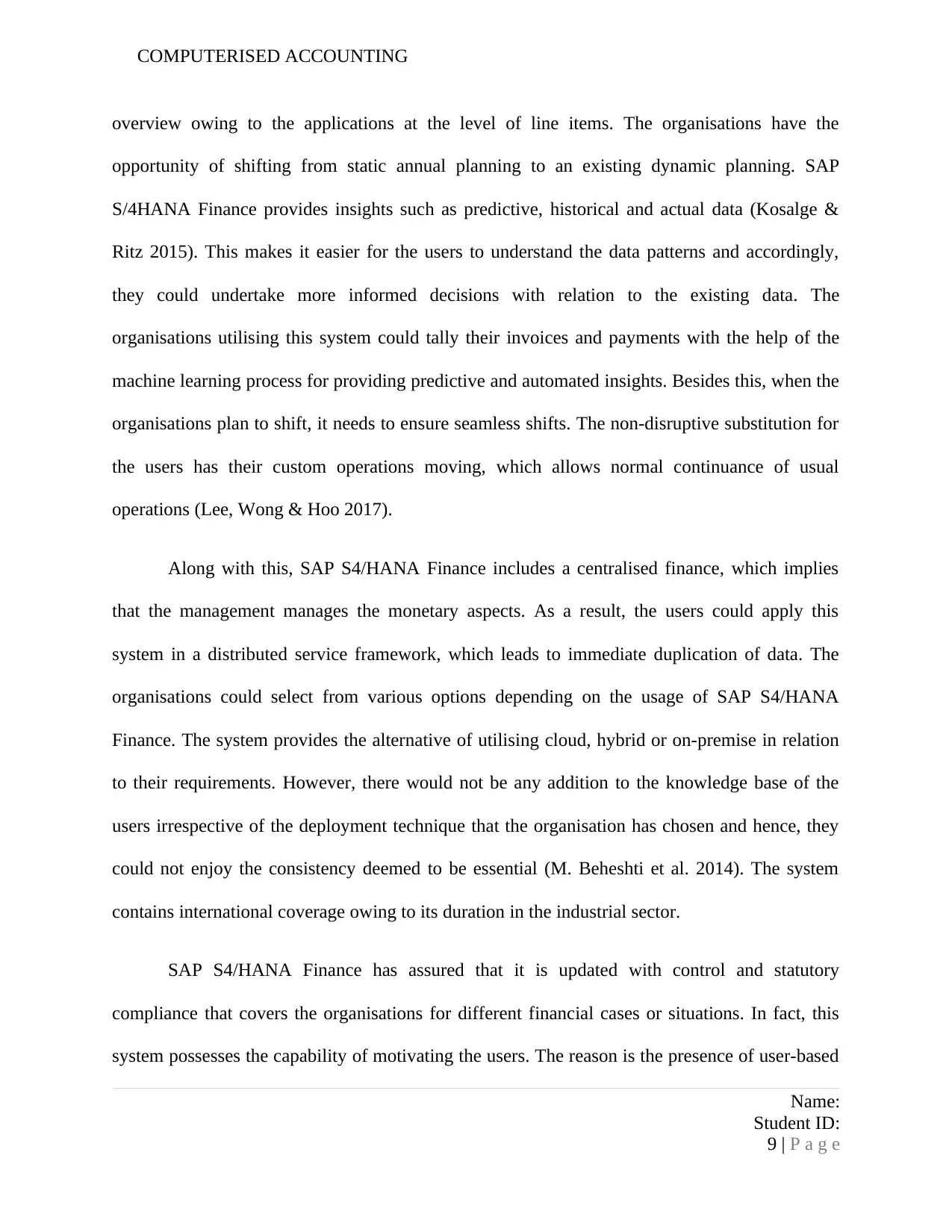
COMPUTERISED ACCOUNTING
overview owing to the applications at the level of line items. The organisations have the
opportunity of shifting from static annual planning to an existing dynamic planning. SAP
S/4HANA Finance provides insights such as predictive, historical and actual data (Kosalge &
Ritz 2015). This makes it easier for the users to understand the data patterns and accordingly,
they could undertake more informed decisions with relation to the existing data. The
organisations utilising this system could tally their invoices and payments with the help of the
machine learning process for providing predictive and automated insights. Besides this, when the
organisations plan to shift, it needs to ensure seamless shifts. The non-disruptive substitution for
the users has their custom operations moving, which allows normal continuance of usual
operations (Lee, Wong & Hoo 2017).
Along with this, SAP S4/HANA Finance includes a centralised finance, which implies
that the management manages the monetary aspects. As a result, the users could apply this
system in a distributed service framework, which leads to immediate duplication of data. The
organisations could select from various options depending on the usage of SAP S4/HANA
Finance. The system provides the alternative of utilising cloud, hybrid or on-premise in relation
to their requirements. However, there would not be any addition to the knowledge base of the
users irrespective of the deployment technique that the organisation has chosen and hence, they
could not enjoy the consistency deemed to be essential (M. Beheshti et al. 2014). The system
contains international coverage owing to its duration in the industrial sector.
SAP S4/HANA Finance has assured that it is updated with control and statutory
compliance that covers the organisations for different financial cases or situations. In fact, this
system possesses the capability of motivating the users. The reason is the presence of user-based
Name:
Student ID:
9 | P a g e
overview owing to the applications at the level of line items. The organisations have the
opportunity of shifting from static annual planning to an existing dynamic planning. SAP
S/4HANA Finance provides insights such as predictive, historical and actual data (Kosalge &
Ritz 2015). This makes it easier for the users to understand the data patterns and accordingly,
they could undertake more informed decisions with relation to the existing data. The
organisations utilising this system could tally their invoices and payments with the help of the
machine learning process for providing predictive and automated insights. Besides this, when the
organisations plan to shift, it needs to ensure seamless shifts. The non-disruptive substitution for
the users has their custom operations moving, which allows normal continuance of usual
operations (Lee, Wong & Hoo 2017).
Along with this, SAP S4/HANA Finance includes a centralised finance, which implies
that the management manages the monetary aspects. As a result, the users could apply this
system in a distributed service framework, which leads to immediate duplication of data. The
organisations could select from various options depending on the usage of SAP S4/HANA
Finance. The system provides the alternative of utilising cloud, hybrid or on-premise in relation
to their requirements. However, there would not be any addition to the knowledge base of the
users irrespective of the deployment technique that the organisation has chosen and hence, they
could not enjoy the consistency deemed to be essential (M. Beheshti et al. 2014). The system
contains international coverage owing to its duration in the industrial sector.
SAP S4/HANA Finance has assured that it is updated with control and statutory
compliance that covers the organisations for different financial cases or situations. In fact, this
system possesses the capability of motivating the users. The reason is the presence of user-based
Name:
Student ID:
9 | P a g e
Secure Best Marks with AI Grader
Need help grading? Try our AI Grader for instant feedback on your assignments.
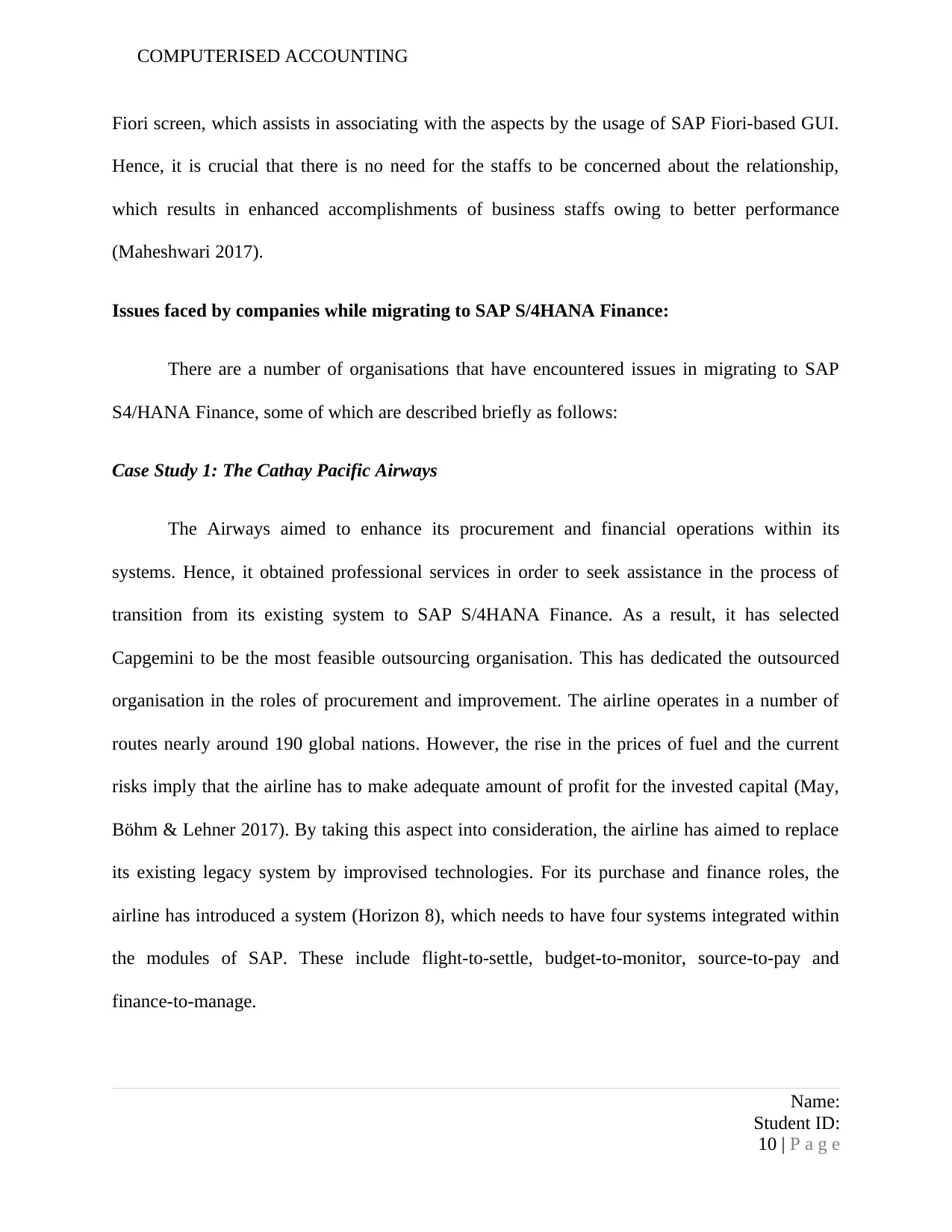
COMPUTERISED ACCOUNTING
Fiori screen, which assists in associating with the aspects by the usage of SAP Fiori-based GUI.
Hence, it is crucial that there is no need for the staffs to be concerned about the relationship,
which results in enhanced accomplishments of business staffs owing to better performance
(Maheshwari 2017).
Issues faced by companies while migrating to SAP S/4HANA Finance:
There are a number of organisations that have encountered issues in migrating to SAP
S4/HANA Finance, some of which are described briefly as follows:
Case Study 1: The Cathay Pacific Airways
The Airways aimed to enhance its procurement and financial operations within its
systems. Hence, it obtained professional services in order to seek assistance in the process of
transition from its existing system to SAP S/4HANA Finance. As a result, it has selected
Capgemini to be the most feasible outsourcing organisation. This has dedicated the outsourced
organisation in the roles of procurement and improvement. The airline operates in a number of
routes nearly around 190 global nations. However, the rise in the prices of fuel and the current
risks imply that the airline has to make adequate amount of profit for the invested capital (May,
Böhm & Lehner 2017). By taking this aspect into consideration, the airline has aimed to replace
its existing legacy system by improvised technologies. For its purchase and finance roles, the
airline has introduced a system (Horizon 8), which needs to have four systems integrated within
the modules of SAP. These include flight-to-settle, budget-to-monitor, source-to-pay and
finance-to-manage.
Name:
Student ID:
10 | P a g e
Fiori screen, which assists in associating with the aspects by the usage of SAP Fiori-based GUI.
Hence, it is crucial that there is no need for the staffs to be concerned about the relationship,
which results in enhanced accomplishments of business staffs owing to better performance
(Maheshwari 2017).
Issues faced by companies while migrating to SAP S/4HANA Finance:
There are a number of organisations that have encountered issues in migrating to SAP
S4/HANA Finance, some of which are described briefly as follows:
Case Study 1: The Cathay Pacific Airways
The Airways aimed to enhance its procurement and financial operations within its
systems. Hence, it obtained professional services in order to seek assistance in the process of
transition from its existing system to SAP S/4HANA Finance. As a result, it has selected
Capgemini to be the most feasible outsourcing organisation. This has dedicated the outsourced
organisation in the roles of procurement and improvement. The airline operates in a number of
routes nearly around 190 global nations. However, the rise in the prices of fuel and the current
risks imply that the airline has to make adequate amount of profit for the invested capital (May,
Böhm & Lehner 2017). By taking this aspect into consideration, the airline has aimed to replace
its existing legacy system by improvised technologies. For its purchase and finance roles, the
airline has introduced a system (Horizon 8), which needs to have four systems integrated within
the modules of SAP. These include flight-to-settle, budget-to-monitor, source-to-pay and
finance-to-manage.
Name:
Student ID:
10 | P a g e
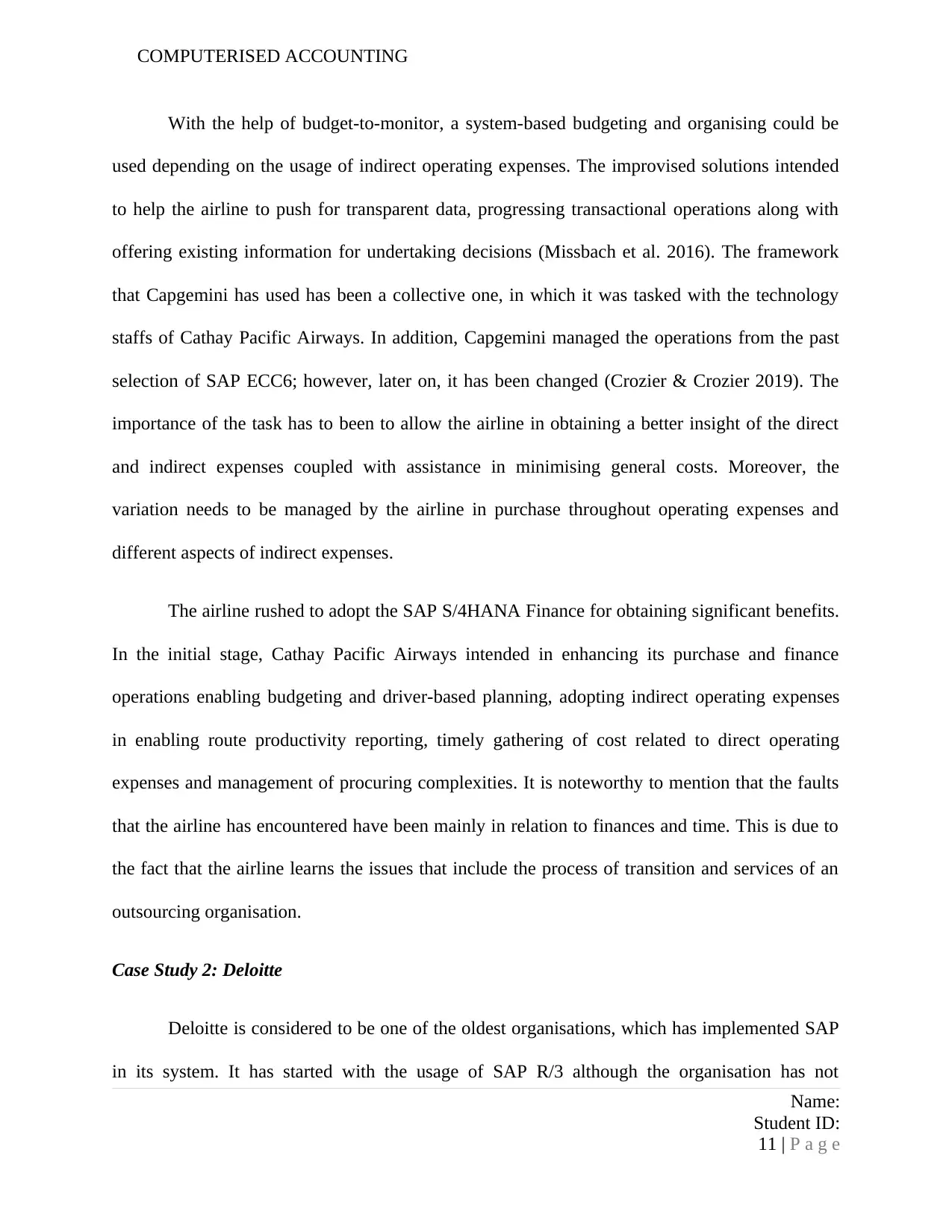
COMPUTERISED ACCOUNTING
With the help of budget-to-monitor, a system-based budgeting and organising could be
used depending on the usage of indirect operating expenses. The improvised solutions intended
to help the airline to push for transparent data, progressing transactional operations along with
offering existing information for undertaking decisions (Missbach et al. 2016). The framework
that Capgemini has used has been a collective one, in which it was tasked with the technology
staffs of Cathay Pacific Airways. In addition, Capgemini managed the operations from the past
selection of SAP ECC6; however, later on, it has been changed (Crozier & Crozier 2019). The
importance of the task has to been to allow the airline in obtaining a better insight of the direct
and indirect expenses coupled with assistance in minimising general costs. Moreover, the
variation needs to be managed by the airline in purchase throughout operating expenses and
different aspects of indirect expenses.
The airline rushed to adopt the SAP S/4HANA Finance for obtaining significant benefits.
In the initial stage, Cathay Pacific Airways intended in enhancing its purchase and finance
operations enabling budgeting and driver-based planning, adopting indirect operating expenses
in enabling route productivity reporting, timely gathering of cost related to direct operating
expenses and management of procuring complexities. It is noteworthy to mention that the faults
that the airline has encountered have been mainly in relation to finances and time. This is due to
the fact that the airline learns the issues that include the process of transition and services of an
outsourcing organisation.
Case Study 2: Deloitte
Deloitte is considered to be one of the oldest organisations, which has implemented SAP
in its system. It has started with the usage of SAP R/3 although the organisation has not
Name:
Student ID:
11 | P a g e
With the help of budget-to-monitor, a system-based budgeting and organising could be
used depending on the usage of indirect operating expenses. The improvised solutions intended
to help the airline to push for transparent data, progressing transactional operations along with
offering existing information for undertaking decisions (Missbach et al. 2016). The framework
that Capgemini has used has been a collective one, in which it was tasked with the technology
staffs of Cathay Pacific Airways. In addition, Capgemini managed the operations from the past
selection of SAP ECC6; however, later on, it has been changed (Crozier & Crozier 2019). The
importance of the task has to been to allow the airline in obtaining a better insight of the direct
and indirect expenses coupled with assistance in minimising general costs. Moreover, the
variation needs to be managed by the airline in purchase throughout operating expenses and
different aspects of indirect expenses.
The airline rushed to adopt the SAP S/4HANA Finance for obtaining significant benefits.
In the initial stage, Cathay Pacific Airways intended in enhancing its purchase and finance
operations enabling budgeting and driver-based planning, adopting indirect operating expenses
in enabling route productivity reporting, timely gathering of cost related to direct operating
expenses and management of procuring complexities. It is noteworthy to mention that the faults
that the airline has encountered have been mainly in relation to finances and time. This is due to
the fact that the airline learns the issues that include the process of transition and services of an
outsourcing organisation.
Case Study 2: Deloitte
Deloitte is considered to be one of the oldest organisations, which has implemented SAP
in its system. It has started with the usage of SAP R/3 although the organisation has not
Name:
Student ID:
11 | P a g e

COMPUTERISED ACCOUNTING
developed the same for professional applications. However, the organisation has dedicated in
acquiring the maximum benefits out of the system, which results in system customisation. It
compelled the organisation in carrying out additional SAP customisation in the last few years. As
Deloitte has made many customisations, it denotes that there have been many faulty decisions
undertaken at the time of selecting the SAP S/4HANA Finance, which matched its business
design and requirements (Carey 2017). On the other hand, it is to be noted that when Deloitte has
been implementing the SAP application, advanced version has not been present. It is necessary
that numerous customisations resulting in numerous faults leaving the organisation behind.
The issue encountered by the organisation at the time of using R/3 has been maintenance
issue. It has been a challenge at the time it entered into maintenance because of the increased
customisations (Murray & Akhtar 2016). As a result, it leads to rise in cost associated with
maintenance. In addition, there has been absence of flexibility provided for the customisations
inherent in the systems. The organisation aimed to enhance for eradicating the issues it has been
encountering with the usage of R/3. The organisation has the goal of having SAP S/4HANA
Finance, which would assist with significant financial operations. There would be enhancement
in significant material operations; thus, offering the organisation with existing perceptions and
information on the financial accomplishments.
The organisation has been enjoying additional benefits after the implementation of SAP
S4/HANA Finance. It is making international advancements, which implies that the complexity
of the financial functions of the company are progressing the reasons as well that drove the
organisation to look for new solutions to the issues. Moreover, the organisation chose SAP
S4/HANA Finance, as it got rid of the aspects and resulting in real-time closure. In the past, the
Name:
Student ID:
12 | P a g e
developed the same for professional applications. However, the organisation has dedicated in
acquiring the maximum benefits out of the system, which results in system customisation. It
compelled the organisation in carrying out additional SAP customisation in the last few years. As
Deloitte has made many customisations, it denotes that there have been many faulty decisions
undertaken at the time of selecting the SAP S/4HANA Finance, which matched its business
design and requirements (Carey 2017). On the other hand, it is to be noted that when Deloitte has
been implementing the SAP application, advanced version has not been present. It is necessary
that numerous customisations resulting in numerous faults leaving the organisation behind.
The issue encountered by the organisation at the time of using R/3 has been maintenance
issue. It has been a challenge at the time it entered into maintenance because of the increased
customisations (Murray & Akhtar 2016). As a result, it leads to rise in cost associated with
maintenance. In addition, there has been absence of flexibility provided for the customisations
inherent in the systems. The organisation aimed to enhance for eradicating the issues it has been
encountering with the usage of R/3. The organisation has the goal of having SAP S/4HANA
Finance, which would assist with significant financial operations. There would be enhancement
in significant material operations; thus, offering the organisation with existing perceptions and
information on the financial accomplishments.
The organisation has been enjoying additional benefits after the implementation of SAP
S4/HANA Finance. It is making international advancements, which implies that the complexity
of the financial functions of the company are progressing the reasons as well that drove the
organisation to look for new solutions to the issues. Moreover, the organisation chose SAP
S4/HANA Finance, as it got rid of the aspects and resulting in real-time closure. In the past, the
Name:
Student ID:
12 | P a g e
Paraphrase This Document
Need a fresh take? Get an instant paraphrase of this document with our AI Paraphraser
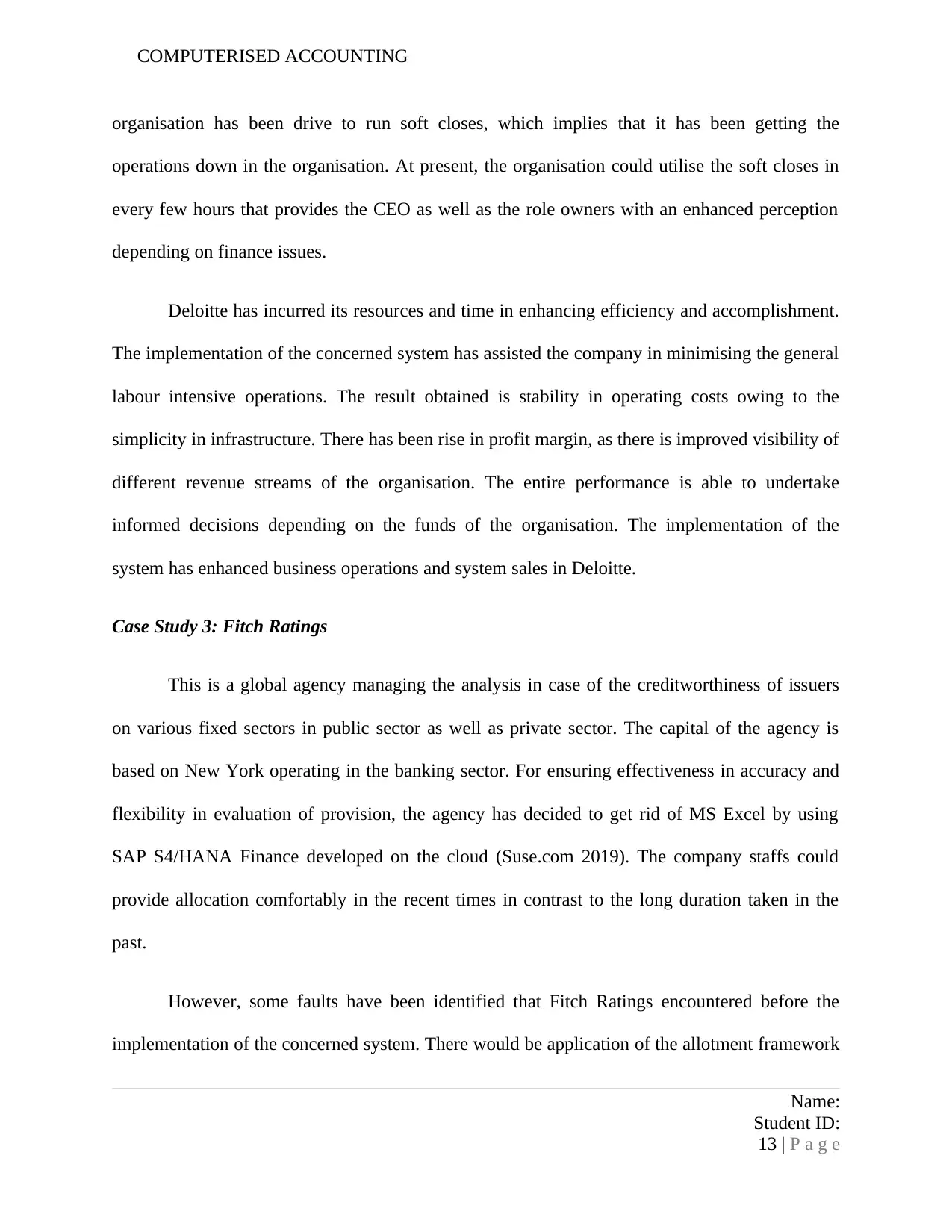
COMPUTERISED ACCOUNTING
organisation has been drive to run soft closes, which implies that it has been getting the
operations down in the organisation. At present, the organisation could utilise the soft closes in
every few hours that provides the CEO as well as the role owners with an enhanced perception
depending on finance issues.
Deloitte has incurred its resources and time in enhancing efficiency and accomplishment.
The implementation of the concerned system has assisted the company in minimising the general
labour intensive operations. The result obtained is stability in operating costs owing to the
simplicity in infrastructure. There has been rise in profit margin, as there is improved visibility of
different revenue streams of the organisation. The entire performance is able to undertake
informed decisions depending on the funds of the organisation. The implementation of the
system has enhanced business operations and system sales in Deloitte.
Case Study 3: Fitch Ratings
This is a global agency managing the analysis in case of the creditworthiness of issuers
on various fixed sectors in public sector as well as private sector. The capital of the agency is
based on New York operating in the banking sector. For ensuring effectiveness in accuracy and
flexibility in evaluation of provision, the agency has decided to get rid of MS Excel by using
SAP S4/HANA Finance developed on the cloud (Suse.com 2019). The company staffs could
provide allocation comfortably in the recent times in contrast to the long duration taken in the
past.
However, some faults have been identified that Fitch Ratings encountered before the
implementation of the concerned system. There would be application of the allotment framework
Name:
Student ID:
13 | P a g e
organisation has been drive to run soft closes, which implies that it has been getting the
operations down in the organisation. At present, the organisation could utilise the soft closes in
every few hours that provides the CEO as well as the role owners with an enhanced perception
depending on finance issues.
Deloitte has incurred its resources and time in enhancing efficiency and accomplishment.
The implementation of the concerned system has assisted the company in minimising the general
labour intensive operations. The result obtained is stability in operating costs owing to the
simplicity in infrastructure. There has been rise in profit margin, as there is improved visibility of
different revenue streams of the organisation. The entire performance is able to undertake
informed decisions depending on the funds of the organisation. The implementation of the
system has enhanced business operations and system sales in Deloitte.
Case Study 3: Fitch Ratings
This is a global agency managing the analysis in case of the creditworthiness of issuers
on various fixed sectors in public sector as well as private sector. The capital of the agency is
based on New York operating in the banking sector. For ensuring effectiveness in accuracy and
flexibility in evaluation of provision, the agency has decided to get rid of MS Excel by using
SAP S4/HANA Finance developed on the cloud (Suse.com 2019). The company staffs could
provide allocation comfortably in the recent times in contrast to the long duration taken in the
past.
However, some faults have been identified that Fitch Ratings encountered before the
implementation of the concerned system. There would be application of the allotment framework
Name:
Student ID:
13 | P a g e
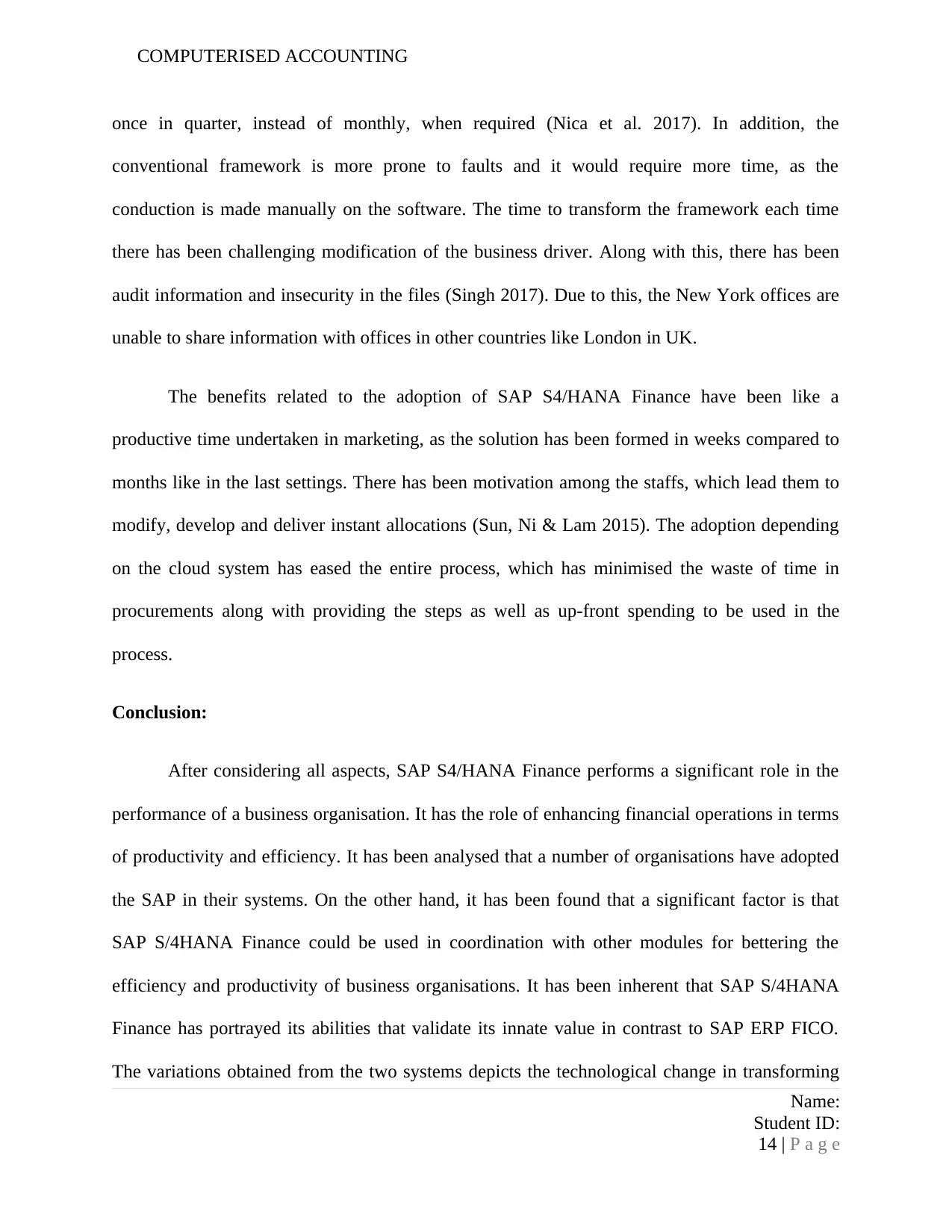
COMPUTERISED ACCOUNTING
once in quarter, instead of monthly, when required (Nica et al. 2017). In addition, the
conventional framework is more prone to faults and it would require more time, as the
conduction is made manually on the software. The time to transform the framework each time
there has been challenging modification of the business driver. Along with this, there has been
audit information and insecurity in the files (Singh 2017). Due to this, the New York offices are
unable to share information with offices in other countries like London in UK.
The benefits related to the adoption of SAP S4/HANA Finance have been like a
productive time undertaken in marketing, as the solution has been formed in weeks compared to
months like in the last settings. There has been motivation among the staffs, which lead them to
modify, develop and deliver instant allocations (Sun, Ni & Lam 2015). The adoption depending
on the cloud system has eased the entire process, which has minimised the waste of time in
procurements along with providing the steps as well as up-front spending to be used in the
process.
Conclusion:
After considering all aspects, SAP S4/HANA Finance performs a significant role in the
performance of a business organisation. It has the role of enhancing financial operations in terms
of productivity and efficiency. It has been analysed that a number of organisations have adopted
the SAP in their systems. On the other hand, it has been found that a significant factor is that
SAP S/4HANA Finance could be used in coordination with other modules for bettering the
efficiency and productivity of business organisations. It has been inherent that SAP S/4HANA
Finance has portrayed its abilities that validate its innate value in contrast to SAP ERP FICO.
The variations obtained from the two systems depicts the technological change in transforming
Name:
Student ID:
14 | P a g e
once in quarter, instead of monthly, when required (Nica et al. 2017). In addition, the
conventional framework is more prone to faults and it would require more time, as the
conduction is made manually on the software. The time to transform the framework each time
there has been challenging modification of the business driver. Along with this, there has been
audit information and insecurity in the files (Singh 2017). Due to this, the New York offices are
unable to share information with offices in other countries like London in UK.
The benefits related to the adoption of SAP S4/HANA Finance have been like a
productive time undertaken in marketing, as the solution has been formed in weeks compared to
months like in the last settings. There has been motivation among the staffs, which lead them to
modify, develop and deliver instant allocations (Sun, Ni & Lam 2015). The adoption depending
on the cloud system has eased the entire process, which has minimised the waste of time in
procurements along with providing the steps as well as up-front spending to be used in the
process.
Conclusion:
After considering all aspects, SAP S4/HANA Finance performs a significant role in the
performance of a business organisation. It has the role of enhancing financial operations in terms
of productivity and efficiency. It has been analysed that a number of organisations have adopted
the SAP in their systems. On the other hand, it has been found that a significant factor is that
SAP S/4HANA Finance could be used in coordination with other modules for bettering the
efficiency and productivity of business organisations. It has been inherent that SAP S/4HANA
Finance has portrayed its abilities that validate its innate value in contrast to SAP ERP FICO.
The variations obtained from the two systems depicts the technological change in transforming
Name:
Student ID:
14 | P a g e
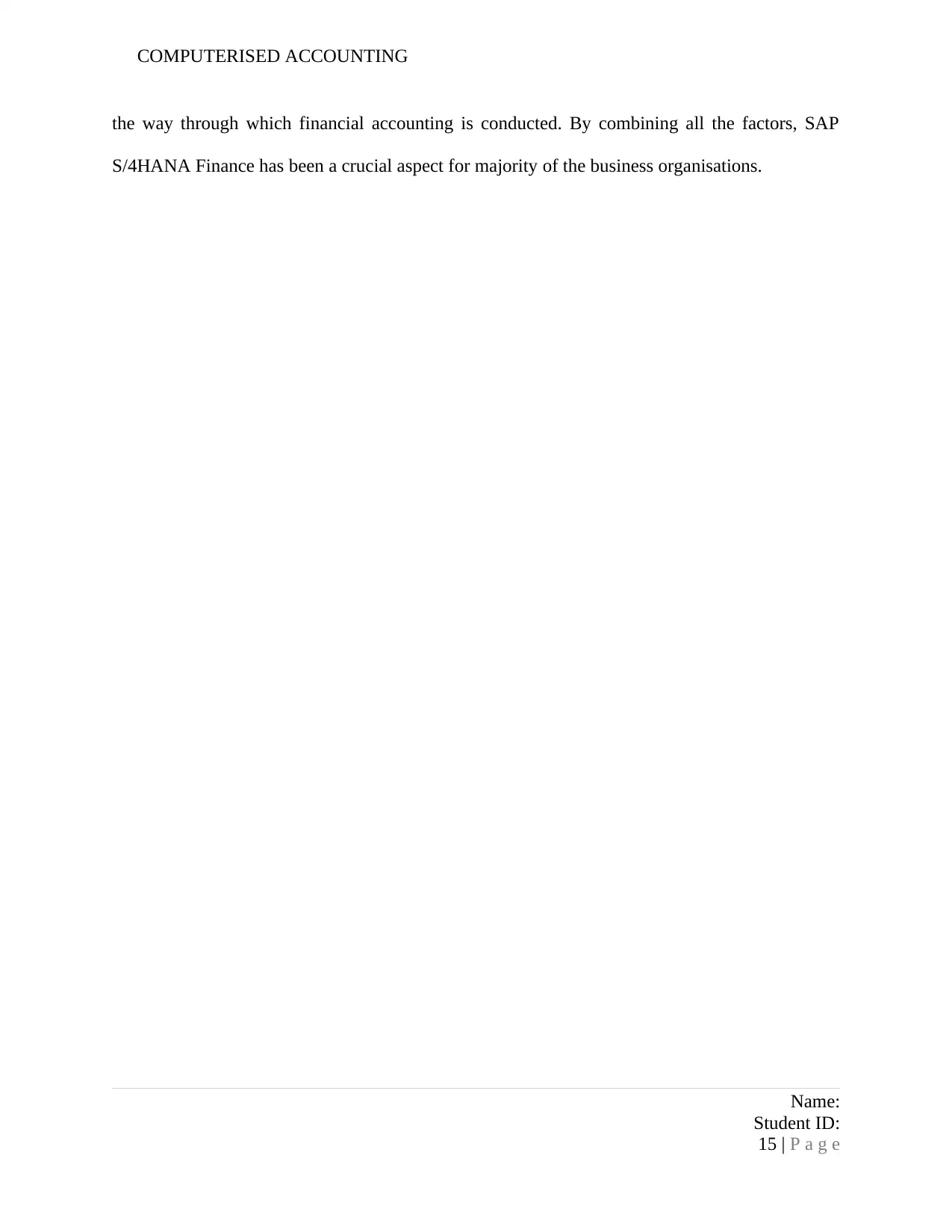
COMPUTERISED ACCOUNTING
the way through which financial accounting is conducted. By combining all the factors, SAP
S/4HANA Finance has been a crucial aspect for majority of the business organisations.
Name:
Student ID:
15 | P a g e
the way through which financial accounting is conducted. By combining all the factors, SAP
S/4HANA Finance has been a crucial aspect for majority of the business organisations.
Name:
Student ID:
15 | P a g e
Secure Best Marks with AI Grader
Need help grading? Try our AI Grader for instant feedback on your assignments.
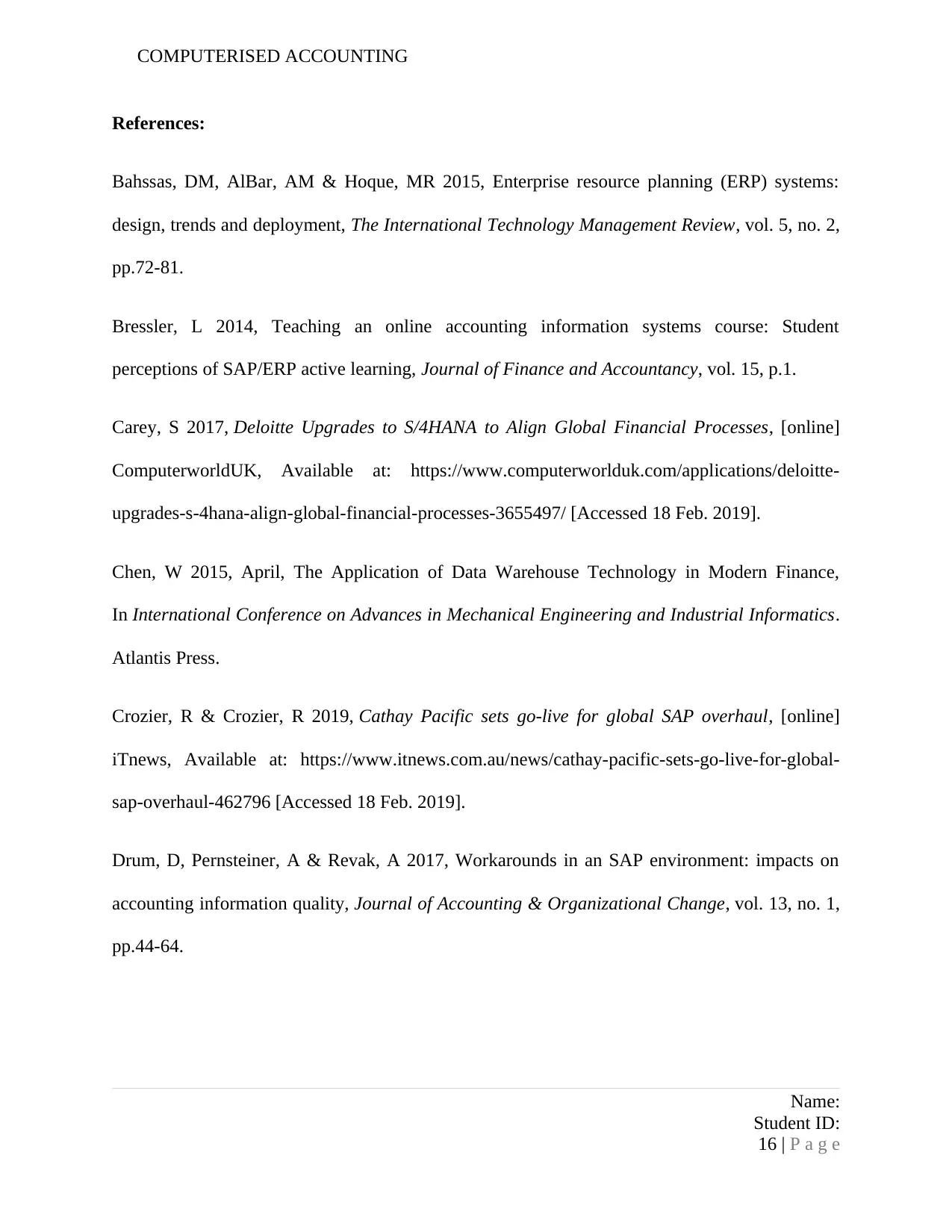
COMPUTERISED ACCOUNTING
References:
Bahssas, DM, AlBar, AM & Hoque, MR 2015, Enterprise resource planning (ERP) systems:
design, trends and deployment, The International Technology Management Review, vol. 5, no. 2,
pp.72-81.
Bressler, L 2014, Teaching an online accounting information systems course: Student
perceptions of SAP/ERP active learning, Journal of Finance and Accountancy, vol. 15, p.1.
Carey, S 2017, Deloitte Upgrades to S/4HANA to Align Global Financial Processes, [online]
ComputerworldUK, Available at: https://www.computerworlduk.com/applications/deloitte-
upgrades-s-4hana-align-global-financial-processes-3655497/ [Accessed 18 Feb. 2019].
Chen, W 2015, April, The Application of Data Warehouse Technology in Modern Finance,
In International Conference on Advances in Mechanical Engineering and Industrial Informatics.
Atlantis Press.
Crozier, R & Crozier, R 2019, Cathay Pacific sets go-live for global SAP overhaul, [online]
iTnews, Available at: https://www.itnews.com.au/news/cathay-pacific-sets-go-live-for-global-
sap-overhaul-462796 [Accessed 18 Feb. 2019].
Drum, D, Pernsteiner, A & Revak, A 2017, Workarounds in an SAP environment: impacts on
accounting information quality, Journal of Accounting & Organizational Change, vol. 13, no. 1,
pp.44-64.
Name:
Student ID:
16 | P a g e
References:
Bahssas, DM, AlBar, AM & Hoque, MR 2015, Enterprise resource planning (ERP) systems:
design, trends and deployment, The International Technology Management Review, vol. 5, no. 2,
pp.72-81.
Bressler, L 2014, Teaching an online accounting information systems course: Student
perceptions of SAP/ERP active learning, Journal of Finance and Accountancy, vol. 15, p.1.
Carey, S 2017, Deloitte Upgrades to S/4HANA to Align Global Financial Processes, [online]
ComputerworldUK, Available at: https://www.computerworlduk.com/applications/deloitte-
upgrades-s-4hana-align-global-financial-processes-3655497/ [Accessed 18 Feb. 2019].
Chen, W 2015, April, The Application of Data Warehouse Technology in Modern Finance,
In International Conference on Advances in Mechanical Engineering and Industrial Informatics.
Atlantis Press.
Crozier, R & Crozier, R 2019, Cathay Pacific sets go-live for global SAP overhaul, [online]
iTnews, Available at: https://www.itnews.com.au/news/cathay-pacific-sets-go-live-for-global-
sap-overhaul-462796 [Accessed 18 Feb. 2019].
Drum, D, Pernsteiner, A & Revak, A 2017, Workarounds in an SAP environment: impacts on
accounting information quality, Journal of Accounting & Organizational Change, vol. 13, no. 1,
pp.44-64.
Name:
Student ID:
16 | P a g e
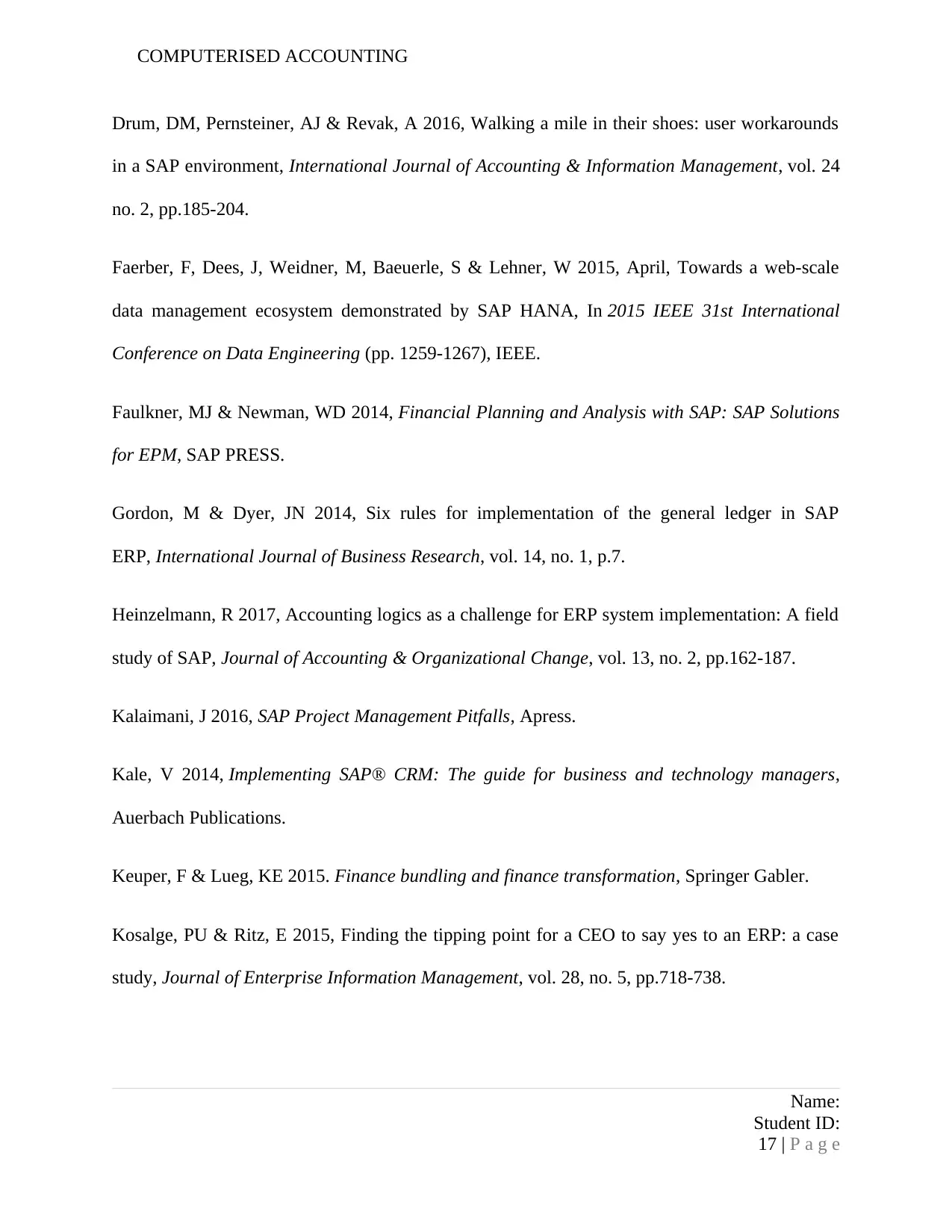
COMPUTERISED ACCOUNTING
Drum, DM, Pernsteiner, AJ & Revak, A 2016, Walking a mile in their shoes: user workarounds
in a SAP environment, International Journal of Accounting & Information Management, vol. 24
no. 2, pp.185-204.
Faerber, F, Dees, J, Weidner, M, Baeuerle, S & Lehner, W 2015, April, Towards a web-scale
data management ecosystem demonstrated by SAP HANA, In 2015 IEEE 31st International
Conference on Data Engineering (pp. 1259-1267), IEEE.
Faulkner, MJ & Newman, WD 2014, Financial Planning and Analysis with SAP: SAP Solutions
for EPM, SAP PRESS.
Gordon, M & Dyer, JN 2014, Six rules for implementation of the general ledger in SAP
ERP, International Journal of Business Research, vol. 14, no. 1, p.7.
Heinzelmann, R 2017, Accounting logics as a challenge for ERP system implementation: A field
study of SAP, Journal of Accounting & Organizational Change, vol. 13, no. 2, pp.162-187.
Kalaimani, J 2016, SAP Project Management Pitfalls, Apress.
Kale, V 2014, Implementing SAP® CRM: The guide for business and technology managers,
Auerbach Publications.
Keuper, F & Lueg, KE 2015. Finance bundling and finance transformation, Springer Gabler.
Kosalge, PU & Ritz, E 2015, Finding the tipping point for a CEO to say yes to an ERP: a case
study, Journal of Enterprise Information Management, vol. 28, no. 5, pp.718-738.
Name:
Student ID:
17 | P a g e
Drum, DM, Pernsteiner, AJ & Revak, A 2016, Walking a mile in their shoes: user workarounds
in a SAP environment, International Journal of Accounting & Information Management, vol. 24
no. 2, pp.185-204.
Faerber, F, Dees, J, Weidner, M, Baeuerle, S & Lehner, W 2015, April, Towards a web-scale
data management ecosystem demonstrated by SAP HANA, In 2015 IEEE 31st International
Conference on Data Engineering (pp. 1259-1267), IEEE.
Faulkner, MJ & Newman, WD 2014, Financial Planning and Analysis with SAP: SAP Solutions
for EPM, SAP PRESS.
Gordon, M & Dyer, JN 2014, Six rules for implementation of the general ledger in SAP
ERP, International Journal of Business Research, vol. 14, no. 1, p.7.
Heinzelmann, R 2017, Accounting logics as a challenge for ERP system implementation: A field
study of SAP, Journal of Accounting & Organizational Change, vol. 13, no. 2, pp.162-187.
Kalaimani, J 2016, SAP Project Management Pitfalls, Apress.
Kale, V 2014, Implementing SAP® CRM: The guide for business and technology managers,
Auerbach Publications.
Keuper, F & Lueg, KE 2015. Finance bundling and finance transformation, Springer Gabler.
Kosalge, PU & Ritz, E 2015, Finding the tipping point for a CEO to say yes to an ERP: a case
study, Journal of Enterprise Information Management, vol. 28, no. 5, pp.718-738.
Name:
Student ID:
17 | P a g e

COMPUTERISED ACCOUNTING
Lee, MJ, Wong, WY & Hoo, MH 2017, December, Next era of enterprise resource planning
system review on traditional on-premise ERP versus Cloud-based ERP: Factors influence
decision on migration to Cloud-based ERP for Malaysian SMEs/SMIs, In 2017 IEEE Conference
on Systems, Process and Control (ICSPC) (pp. 48-53). IEEE.
M. Beheshti, H, K. Blaylock, B, A. Henderson, D. & G. Lollar, J 2014, Selection and critical
success factors in successful ERP implementation, Competitiveness Review, vol 24, no. 4,
pp.357-375.
Maheshwari, A 2017, Implementing SAP S/4HANA Finance (SAP PRESS), SAP PRESS.
May, N, Böhm, A & Lehner, W 2017, SAP HANA–The Evolution of an In-Memory DBMS
from Pure OLAP Processing Towards Mixed Workloads, Datenbanksysteme für Business,
Technologie und Web (BTW 2017).
Missbach, M, Staerk, T, Gardiner, C, McCloud, J, Madl, R, Tempes, M and Anderson, G
2016, SAP on the Cloud (pp. 7-8), Heidelberg: Springer.
Murray, M & Akhtar, J 2016, Materials Management with SAP ERP: Functionality and
Technical Configuration, Rheinwerk Publishing.
Nica, A, Sherkat, R, Andrei, M, Cheng, X, Heidel, M, Bensberg, C & Gerwens, H 2017,
Statisticum: Data statistics management in SAP HANA, Proceedings of the VLDB
Endowment, vol. 10, no. 12, pp.1658-1669.
Singh, V 2017, Manage Your SAP Projects with SAP Activate: Implementing SAP S/4HANA,
Packt Publishing Ltd.
Name:
Student ID:
18 | P a g e
Lee, MJ, Wong, WY & Hoo, MH 2017, December, Next era of enterprise resource planning
system review on traditional on-premise ERP versus Cloud-based ERP: Factors influence
decision on migration to Cloud-based ERP for Malaysian SMEs/SMIs, In 2017 IEEE Conference
on Systems, Process and Control (ICSPC) (pp. 48-53). IEEE.
M. Beheshti, H, K. Blaylock, B, A. Henderson, D. & G. Lollar, J 2014, Selection and critical
success factors in successful ERP implementation, Competitiveness Review, vol 24, no. 4,
pp.357-375.
Maheshwari, A 2017, Implementing SAP S/4HANA Finance (SAP PRESS), SAP PRESS.
May, N, Böhm, A & Lehner, W 2017, SAP HANA–The Evolution of an In-Memory DBMS
from Pure OLAP Processing Towards Mixed Workloads, Datenbanksysteme für Business,
Technologie und Web (BTW 2017).
Missbach, M, Staerk, T, Gardiner, C, McCloud, J, Madl, R, Tempes, M and Anderson, G
2016, SAP on the Cloud (pp. 7-8), Heidelberg: Springer.
Murray, M & Akhtar, J 2016, Materials Management with SAP ERP: Functionality and
Technical Configuration, Rheinwerk Publishing.
Nica, A, Sherkat, R, Andrei, M, Cheng, X, Heidel, M, Bensberg, C & Gerwens, H 2017,
Statisticum: Data statistics management in SAP HANA, Proceedings of the VLDB
Endowment, vol. 10, no. 12, pp.1658-1669.
Singh, V 2017, Manage Your SAP Projects with SAP Activate: Implementing SAP S/4HANA,
Packt Publishing Ltd.
Name:
Student ID:
18 | P a g e
Paraphrase This Document
Need a fresh take? Get an instant paraphrase of this document with our AI Paraphraser
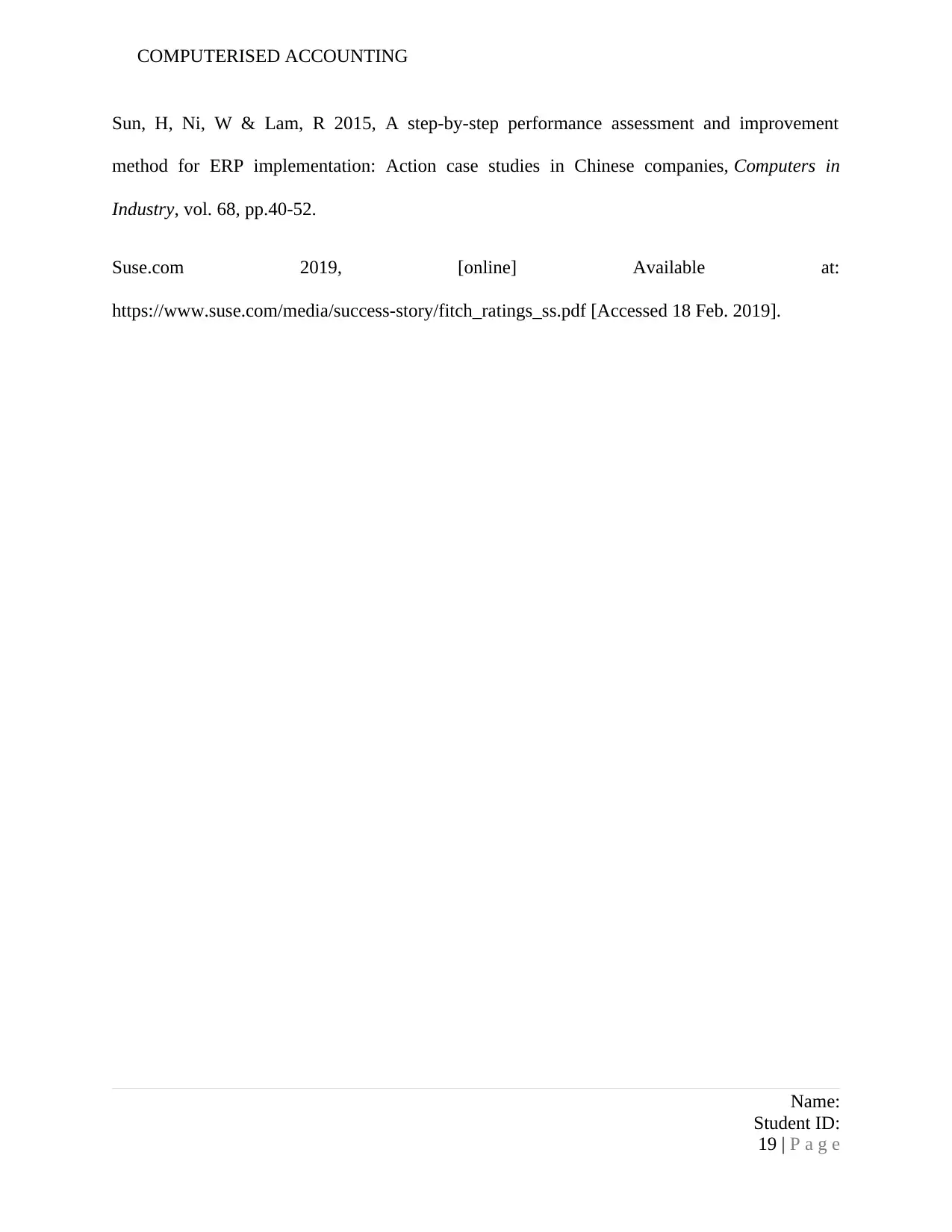
COMPUTERISED ACCOUNTING
Sun, H, Ni, W & Lam, R 2015, A step-by-step performance assessment and improvement
method for ERP implementation: Action case studies in Chinese companies, Computers in
Industry, vol. 68, pp.40-52.
Suse.com 2019, [online] Available at:
https://www.suse.com/media/success-story/fitch_ratings_ss.pdf [Accessed 18 Feb. 2019].
Name:
Student ID:
19 | P a g e
Sun, H, Ni, W & Lam, R 2015, A step-by-step performance assessment and improvement
method for ERP implementation: Action case studies in Chinese companies, Computers in
Industry, vol. 68, pp.40-52.
Suse.com 2019, [online] Available at:
https://www.suse.com/media/success-story/fitch_ratings_ss.pdf [Accessed 18 Feb. 2019].
Name:
Student ID:
19 | P a g e
1 out of 20
Related Documents
Your All-in-One AI-Powered Toolkit for Academic Success.
+13062052269
info@desklib.com
Available 24*7 on WhatsApp / Email
![[object Object]](/_next/static/media/star-bottom.7253800d.svg)
Unlock your academic potential
© 2024 | Zucol Services PVT LTD | All rights reserved.





